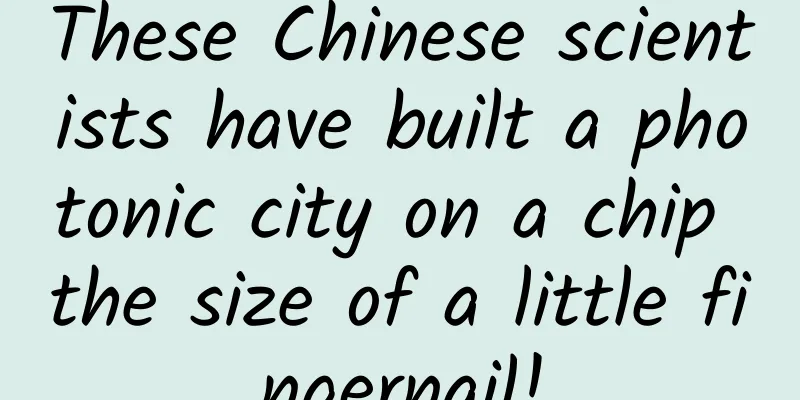These Chinese scientists have built a photonic city on a chip the size of a little fingernail!

|
Produced by: Science Popularization China Author: Luan Chunyang (PhD, Department of Physics, Tsinghua University) Producer: China Science Expo Imagine if we could manipulate light’s various degrees of freedom, even its secret identity — its quantum state? This is exactly the miracle promised by optical quantum computing. It's not just super-fast, it's also low-energy, high-bandwidth, and able to process massive amounts of information simultaneously, like a "super photonic brain." However, integrating these photons into a tiny photonic quantum chip is like building a photon city, which is an extremely complex experimental task. However, good news has come! Figure 1 Physical picture of ultra-large-scale integrated photonic quantum chip (Image source: Nature Photonics) References [1] In April 2023, a research team led by Peking University researcher Wang Jianwei and Professor Gong Qihuang successfully solved the manufacturing problem of ultra-large-scale integrated photonic quantum chips through joint efforts with partners, and mastered the key technology of manipulating photonic quantum states. They developed an innovative photonic quantum chip - "Boya No. 1". The "Boya No. 1" optical quantum chip uses multi-photon technology and realizes the preparation and control of high-dimensional quantum entangled states for the first time, which is a major breakthrough in the field of optical quantum computing. In addition, scientists have successfully demonstrated a programmable Bose sampling quantum computing task based on graph theory on the optical quantum chip. This research result was published in the world's top academic journal Nature Photonics. The title of the paper is "Very-large-scale integrated quantum graph photonics". This is a major advancement in the field of optical quantum computing and also a bold imagination of our future technology. Figure 2: The academic paper “Graph Quantum Photonics for Ultra-Large Scale Integration” published in Nature Photonics (Image source: Nature Photonics) References [1] 1. When graph theory meets photonic quantum chips: a “two-way journey” between mathematics and physics Imagine walking into a lab with two scientists: a mathematician working in graph theory and a physicist working in optical quantum computing. This combination is like the bread and peanut butter of science—a powerful combination that could yield unexpectedly delicious results. The mathematician might speak first, and his words are full of love for graph theory. He might say: "Graph theory is like a kind of mathematical magic that allows us to simplify the complex world into vertices and edges. Imagine that each vertex is a research object, and each edge is the logical relationship between research objects. We can compare cities to vertices and roads to edges, and construct a traffic network diagram between cities." When the physicist heard this, his eyes lit up immediately. He might excitedly say, "This is great! In optical quantum computing, we are doing something similar. We use photons, which are particles of light, to weave photon networks of quantum information. Just like you mathematicians use vertices and edges to describe the complex world, we can also use photons and their quantum interference effects to build networks for optical quantum computing." The mathematician and the physicist smiled at each other, realizing that they could work together to create miracles. The mathematician added: "I can transform your photon network into a graph in graph theory, so that we can use mathematical tools to analyze and optimize the behavior of photons." Figure 3 Schematic diagram of urban transportation network (Photo source: VEER Gallery) The physicist happily responded: "Yes! We can design experiments to make photons travel along specific paths, just like finding the shortest path in graph theory. In this way, we can build a photon city and create a completely new solution for photon computing." So they began to work together to combine the visualization capabilities of graph theory with the powerful computing power of optical quantum computing. They created a method of "arbitrarily programmable Bose sampling quantum computing", which is like a photon traffic network tailored for photons, allowing them to travel through the photon city in the most efficient way. 2. Bose sampling quantum computing: a complex photon traffic network "Boson sampling quantum computing" may sound a bit complicated, but it is actually a quantum computing model that aims to demonstrate that quantum computers have significant advantages over classical computers when dealing with certain specific problems. Specifically, the Bose sampling quantum operation involves sending multiple photons (a type of boson) into a linear optical network, where these photons will produce quantum interference in the network. In order to measure the output probability distribution of these photons in the photonic network, we use single-photon detectors to detect the photon distribution at the output port. It should be noted that the output of the Bose sampling quantum operation is highly random, and as the number of photons increases, the probability distribution of the calculated output becomes extremely complex. This makes it extremely difficult for classical computers to simulate the Bose sampling process, and this difficulty increases exponentially with the increase in the number of photons. In contrast, quantum computers can handle such tasks more efficiently. Figure 4 Schematic diagram of the photon network of the optical quantum chip "Boya No. 1" (Image source: Nature Photonics) References [1] To understand "arbitrarily programmable Bose sampling quantum computing" more intuitively, we can imagine it as building a tiny and complex photon traffic network, similar to the urban traffic system, but designed specifically for photons. In this photon transportation network, light sources are like a special bus terminal, emitting photons like cars, and these photon cars can also interconnect information with each other. These light sources are connected to an intricate photon transportation network, in which photon cars can shuttle freely. "Arbitrarily programmable Bose sampling quantum computing" allows us to arbitrarily plan the driving paths of photon cars according to computing needs, thereby optimizing this photon traffic network. This is like finding the best route from point A to point B in a photon city. In addition, scientists can also measure specific properties of this photon traffic network, which is similar to calculating how many ways each photon car can find a parking space in a complex photon city network. Figure 5 Schematic diagram of photons traveling through the photon city (Photo source: VEER Gallery) Therefore, the optical quantum computing experiment based on graph theory actually uses graph theory to design and understand this photon city. Graph theory is like a traffic map, which helps us understand the traffic in the photon city and also helps scientists design and predict the complex behavior of photons in the photon traffic network. 3. Building a photon city on a tiny chip Professor Anton Zeilinger, an Austrian scientist and one of the winners of the 2022 Nobel Prize in Physics, proposed a theoretical framework that closely combines graph theory and quantum optical systems. In this framework, scientists can use the visualization characteristics of graph theory and mathematical tools to describe the calculation process of light quantum experiments in detail and explore new quantum phenomena. Figure 6 The correspondence between optical quantum computing network and graph theory (Image source: Nature Photonics) References [1] To verify this theory, a research team led by Peking University researcher Wang Jianwei and Professor Gong Qihuang and their collaborators built a real photon city in a photon chip that is only about the size of a fingernail. In this photon city, there are about 2,500 precision optical components, and photon computing and information processing based on graph theory have been successfully realized. In addition, scientists have overcome the challenges of large-scale photonic quantum chip design, manufacturing, control and experimental measurement, and developed large-scale integrated photonic quantum chip production technology and quantum control methods. These research results show that scientists will be able to mass-produce such photonic cities in the future and customize photonic transportation networks according to specific computing needs. It is worth mentioning that scientists have also created a special photon state in the photon quantum chip, called "high-dimensional quantum entangled state" . This is like upgrading an ordinary photon car to a double-decker or multi-layer photon super bus, which greatly expands the information dimension of photons during transmission. These photon super buses can also achieve information interconnection by sharing quantum entangled states with each other. 4. "Boya No. 1" brings more possibilities for chips and quantum technology As mentioned above, scientists have made remarkable achievements on the "Boya No. 1" optical quantum chip: they have not only successfully prepared multi-photon high-dimensional quantum entangled states, but also achieved precise control, measurement and verification of them. These achievements have been verified under the unified framework of graph theory, proving that the optical quantum chip can efficiently perform graph theory-related quantum information processing and quantum computing tasks. Figure 7 Artistic diagram of photon quantum state (Photo source: VEER Gallery) What does this mean? It marks an important step towards large-scale integrated optical quantum computing chips based on graph theory. It not only demonstrates the ability to precisely control photons at a microscopic scale, but also proves the feasibility of large-scale integrated quantum optical experiments. These achievements not only have far-reaching scientific research significance, but also lay a solid foundation for the commercialization and large-scale production of quantum technology. References [1] Bao J, Fu Z, Pramanik T, et al. Very-large-scale integrated quantum graph photonics[J]. Nature Photonics, 2023, 17(7): 573-581. |
>>: Why is it that when someone tries to look cool, it easily offends others?
Recommend
SEM bidding promotion account building
Paid bidding promotion has always been an importa...
Subsidy policy for households with two daughters in 2022: What are the conditions for receiving it? How much per year?
A household with two daughters, as the name sugge...
The mobile phone industry is highly mature, but why is it becoming more and more "boring"?
As the mobile phone market matures, more and more...
Apple makes an exception and allows employees to take unreleased prototypes home. The new iPhone is made entirely by remote control
During the COVID-19 pandemic, Apple made an excep...
《Making Money by Selling Content: Creating Hot-selling Products with No Basics, and Making 100,000+ Won Easily Every Month》
It turned out that these people had no sales expe...
Today is the day when black technology is booming
[[164892]] It's April Fools' Day again Te...
Being a performance king and a domestic pioneer, Raytheon helps China's independent science and technology take root
It can be the performance king and is also worthy...
FunDapter - Adds various structured data to ListView.
This article introduces a simpler, easier-to-use,...
[Thoughts Wait for Thinkers] How Elliot Builds a Schizophrenic Mind Elliot Explains 10 Aspects of Schizophrenia Clinical Practice (12 Lectures)
[Thoughts Wait for Thinkers] How Elliot Builds a ...
Analysis of Tik Tok’s refined operation and promotion techniques!
The author of this article analyzes Douyin’s pers...
The event planning effect is poor. How to improve it efficiently and achieve growth?
Event planning and operation are commonplace for ...
There are so many advertising channels, how do you choose?
Faced with the intensified competition of product...
Research on cloud terminal transmission protocol based on SPICE protocol
1. Background The transmission protocol is the co...
The homogeneity ceiling has already appeared. How can the mobile "show field" improve its competitiveness?
The competition in the PC-based "show" ...
Regarding monkeypox, WHO announced that…
WHO declares monkeypox outbreak a "public he...


![[Big brain hole] The BMW H5 advertisement they made lasted 77 minutes and received over 100,000 views, when everyone said that H5 was outdated](/upload/images/67cc18bae124e.webp)






